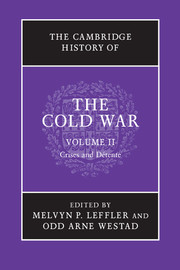Book contents
- Frontmatter
- 1 Grand strategies in the Cold War
- 2 Identity and the Cold War
- 3 Economic aspects of the Cold War, 1962–1975
- 4 The Cuban missile crisis
- 5 Nuclear competition in an era of stalemate, 1963–1975
- 6 US foreign policy from Kennedy to Johnson
- 7 Soviet foreign policy, 1962–1975
- 8 France, “Gaullism,” and the Cold War
- 9 European integration and the Cold War
- 10 Détente in Europe, 1962–1975
- 11 Eastern Europe: Stalinism to Solidarity
- 12 The Cold War and the transformation of the Mediterranean, 1960–1975
- 13 The Cold War in the Third World, 1963–1975
- 14 The Indochina wars and the Cold War, 1945–1975
- 15 The Cold War in the Middle East: Suez crisis to Camp David Accords
- 16 Cuba and the Cold War, 1959–1980
- 17 The Sino-Soviet split
- 18 Détente in the Nixon–Ford years, 1969–1976
- 19 Nuclear proliferation and non-proliferation during the Cold War
- 20 Intelligence in the Cold War
- 21 Reading, viewing, and tuning in to the Cold War
- 22 Counter-cultures: the rebellions against the Cold War order, 1965–1975
- 23 The structure of great power politics, 1963–1975
- 24 The Cold War and the social and economic history of the twentieth century
- Bibliographical essay
- Index
- References
3 - Economic aspects of the Cold War, 1962–1975
Published online by Cambridge University Press: 28 September 2010
- Frontmatter
- 1 Grand strategies in the Cold War
- 2 Identity and the Cold War
- 3 Economic aspects of the Cold War, 1962–1975
- 4 The Cuban missile crisis
- 5 Nuclear competition in an era of stalemate, 1963–1975
- 6 US foreign policy from Kennedy to Johnson
- 7 Soviet foreign policy, 1962–1975
- 8 France, “Gaullism,” and the Cold War
- 9 European integration and the Cold War
- 10 Détente in Europe, 1962–1975
- 11 Eastern Europe: Stalinism to Solidarity
- 12 The Cold War and the transformation of the Mediterranean, 1960–1975
- 13 The Cold War in the Third World, 1963–1975
- 14 The Indochina wars and the Cold War, 1945–1975
- 15 The Cold War in the Middle East: Suez crisis to Camp David Accords
- 16 Cuba and the Cold War, 1959–1980
- 17 The Sino-Soviet split
- 18 Détente in the Nixon–Ford years, 1969–1976
- 19 Nuclear proliferation and non-proliferation during the Cold War
- 20 Intelligence in the Cold War
- 21 Reading, viewing, and tuning in to the Cold War
- 22 Counter-cultures: the rebellions against the Cold War order, 1965–1975
- 23 The structure of great power politics, 1963–1975
- 24 The Cold War and the social and economic history of the twentieth century
- Bibliographical essay
- Index
- References
Summary
US objectives during the Cold War were to prevent Soviet attacks on the United States and its allies and to prevent the spread of Communism as a political and economic system to other countries, whether by force or by threat, subversion, persuasion, or bribery. The principal instrument to prevent attack was an extensive build-up of defensive and retaliatory military forces, combined with political and military alliances that extended US protection to other countries in exchange for their engagement and support. The principal instruments for preventing the spread of Communism by nonmilitary means involved building an international economic system conducive to economic prosperity; engaging in persuasion, providing incentives, and occasionally imposing economic sanctions; and, not least, promoting a robust US economy that could serve as a stimulant to others and as a beacon for the benefits of a free, enterprise-based, market-oriented economy.
This chapter will examine the second set of instruments, usually neglected by historians of the Cold War in favor of a focus on the actual or threatened military actions and the diplomacy associated with them. Following some introductory remarks, the chapter will discuss developments in the world economy and will highlight the comparative economic performance between Communist countries and what was called the “free world.” I will then analyze the actions taken by the United States, including public expenditures on national security and international affairs that were motivated, at least in part, by their international implications.
- Type
- Chapter
- Information
- The Cambridge History of the Cold War , pp. 44 - 64Publisher: Cambridge University PressPrint publication year: 2010
References
- 3
- Cited by

